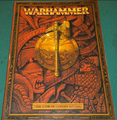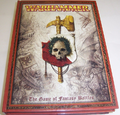Big Red Book: Difference between revisions
1d4chan>Thannak No edit summary |
1d4chan>Thannak No edit summary |
||
| Line 5: | Line 5: | ||
The practice was applied to [[Warhammer 40,000]] as well, and much like how some Fantasy players mistakenly call Army Books "codices", some 40k players call the hardcover rules the Big Red (or Black) Book. 7th edition 40k split the Big Black Book into a set of three books. | The practice was applied to [[Warhammer 40,000]] as well, and much like how some Fantasy players mistakenly call Army Books "codices", some 40k players call the hardcover rules the Big Red (or Black) Book. 7th edition 40k split the Big Black Book into a set of three books. | ||
In 6th Edition however, Games Workshop changed their format; the Big Black Book (now white and red) contained no fluff, but instead was the rules covering the crunch of all of the armies in the game with a guide for new players to choose their first (or additional ones) on preference of playstyle. Fluff books are now sold separately in lieu of codices. Reaction was predictably mixed, some praising it for requiring only one book to play rather than $60 for core and $50 for each army, others readying their torches. | In 6th Edition 40k however, Games Workshop changed their format; the Big Black Book (now white and red) contained no fluff, but instead was the rules covering the crunch of all of the armies in the game with a guide for new players to choose their first (or additional ones) on preference of playstyle. Fluff books are now sold separately in lieu of codices. Reaction was predictably mixed, some praising it for requiring only one book to play rather than $60 for core and $50 for each army, others readying their torches. | ||
Warhammer Fantasy also received a format change at the end of 8th Edition, during the [[End Times]] event. Each book ( | Warhammer Fantasy also received a format change at the end of 8th Edition, during the [[End Times]] event. Each book (between $60 and $80) was FAQ'd into the Big Red Book, changing some rules, adding two armies (made of existing armies combined) to the game, and increasing the number of characters that can be fielded. In the final of these books, all limitations on what your army can and cannot be were lifted besides the models having to come from the same faction; although multiple combined factions allowed the game to become an absolute clusterfuck for a short time where pretty much anything you own could be fielded. | ||
The era of the Big Red Book ended with the true death of Warhammer Fantasy, and the birth of [[Age of Skubmar]]. The core rules, consisting of a mere 4 pages (making the game more simple than any Games Workshop ever put out, including 1e) were made available online. Each model, by the former armies (as now the game consists of only four major factions | The era of the Big Red Book ended with the true death of Warhammer Fantasy, and the birth of [[Age of Skubmar]]. The core rules, consisting of a mere 4 pages (making the game more simple than any Games Workshop ever put out, including 1e) were made available online. Each model, grouped by the former armies (as now the game consists of only four major factions), has rules in digital packs. Any model released after that point has their rules packed in with them, in a similar manner to the early Warhammer model releases. One of the major changes is the complete lack of any upwards limit on what you can bring into a game, or any limitation at all really. If your opponent can only put a maximum of 100 footplodders and 20 elites with a monster or cannon, that doesn't stop you from putting as many models as you can fit in your start zone regardless of what they are onto the field. Furthermore there is no factional restrictions either, allowing a player to simply field the same ultra-powerful characters multiple times; this includes the Thor to [[Sigmar|Sigmar's]] Odin, the Celestiant-Prime, in a clone army made up entirely of copies of himself with each holding hands with an [[Archaon]]. | ||
This lack of internal balance hinges the game now on the rule of fair and intentional gimping play rather than actually limit what you can do and encourage competition, and works into GW's new commitment to simply releasing models and tossing fuckall thought towards anything other than having released another model into preorder. Given the current trend, the new status quo is simply to have '''a''' game exist, meaning the days of the Big Red Book are likely over for good. | |||
As it stands, only 40k continues to receive physical supplements while doomsayers prophesize the coming of Age of Emprah. | |||
<gallery> | <gallery> | ||
Revision as of 23:03, 12 October 2015
A term originating with players of Warhammer Fantasy, the term "Big Red Book" (or BRB) refers to the core rulebook. Although the term began in the 6th edition when, rather than a small booklet containing the rules, large hardcover books were sold, it is also applied to the core books of past editions as well despite not being big or red (rather, resembling the Army Books of today). The books were sold separate from starter sets in a hardcover form which contained glossy full color images of models in different scenes and paint jobs from 'Eavy Metal, and a large section dedicated to the lore of the game. The inclusion of this glorified (if glorious) catalog put the price tag for each editions core rules at $60+.
Despite this, small booklets containing the exact same rules portion and a small amount of lore were packaged with the starter sets of each edition (usually not much more expensive than the BRB) which lead to players looking to update to the practice of buying a starter set, and selling the miniatures they didn't want online (making it very easy for people looking to start an army for one of the armies in that edition starter box to get a beginning force cheap and fast).
The practice was applied to Warhammer 40,000 as well, and much like how some Fantasy players mistakenly call Army Books "codices", some 40k players call the hardcover rules the Big Red (or Black) Book. 7th edition 40k split the Big Black Book into a set of three books.
In 6th Edition 40k however, Games Workshop changed their format; the Big Black Book (now white and red) contained no fluff, but instead was the rules covering the crunch of all of the armies in the game with a guide for new players to choose their first (or additional ones) on preference of playstyle. Fluff books are now sold separately in lieu of codices. Reaction was predictably mixed, some praising it for requiring only one book to play rather than $60 for core and $50 for each army, others readying their torches.
Warhammer Fantasy also received a format change at the end of 8th Edition, during the End Times event. Each book (between $60 and $80) was FAQ'd into the Big Red Book, changing some rules, adding two armies (made of existing armies combined) to the game, and increasing the number of characters that can be fielded. In the final of these books, all limitations on what your army can and cannot be were lifted besides the models having to come from the same faction; although multiple combined factions allowed the game to become an absolute clusterfuck for a short time where pretty much anything you own could be fielded.
The era of the Big Red Book ended with the true death of Warhammer Fantasy, and the birth of Age of Skubmar. The core rules, consisting of a mere 4 pages (making the game more simple than any Games Workshop ever put out, including 1e) were made available online. Each model, grouped by the former armies (as now the game consists of only four major factions), has rules in digital packs. Any model released after that point has their rules packed in with them, in a similar manner to the early Warhammer model releases. One of the major changes is the complete lack of any upwards limit on what you can bring into a game, or any limitation at all really. If your opponent can only put a maximum of 100 footplodders and 20 elites with a monster or cannon, that doesn't stop you from putting as many models as you can fit in your start zone regardless of what they are onto the field. Furthermore there is no factional restrictions either, allowing a player to simply field the same ultra-powerful characters multiple times; this includes the Thor to Sigmar's Odin, the Celestiant-Prime, in a clone army made up entirely of copies of himself with each holding hands with an Archaon.
This lack of internal balance hinges the game now on the rule of fair and intentional gimping play rather than actually limit what you can do and encourage competition, and works into GW's new commitment to simply releasing models and tossing fuckall thought towards anything other than having released another model into preorder. Given the current trend, the new status quo is simply to have a game exist, meaning the days of the Big Red Book are likely over for good.
As it stands, only 40k continues to receive physical supplements while doomsayers prophesize the coming of Age of Emprah.
-
1st Edition, the books that started it all.
-
2e Fantasy
-
5e Fantasy
-
6e Fantasy
-
7e Fantasy
-
8e Fantasy
-
A size comparison between the 8th Edition starter set rulebook, and the Big Red Book.






